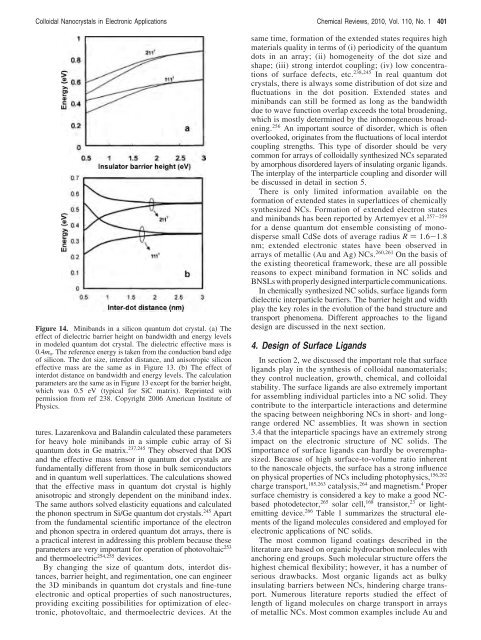Prospects of Colloidal Nanocrystals for Electronic - Computer Science
Prospects of Colloidal Nanocrystals for Electronic - Computer Science
Prospects of Colloidal Nanocrystals for Electronic - Computer Science
You also want an ePaper? Increase the reach of your titles
YUMPU automatically turns print PDFs into web optimized ePapers that Google loves.
<strong>Colloidal</strong> <strong>Nanocrystals</strong> in <strong>Electronic</strong> Applications Chemical Reviews, 2010, Vol. 110, No. 1 401<br />
Figure 14. Minibands in a silicon quantum dot crystal. (a) The<br />
effect <strong>of</strong> dielectric barrier height on bandwidth and energy levels<br />
in modeled quantum dot crystal. The dielectric effective mass is<br />
0.4mo. The reference energy is taken from the conduction band edge<br />
<strong>of</strong> silicon. The dot size, interdot distance, and anisotropic silicon<br />
effective mass are the same as in Figure 13. (b) The effect <strong>of</strong><br />
interdot distance on bandwidth and energy levels. The calculation<br />
parameters are the same as in Figure 13 except <strong>for</strong> the barrier height,<br />
which was 0.5 eV (typical <strong>for</strong> SiC matrix). Reprinted with<br />
permission from ref 238. Copyright 2006 American Institute <strong>of</strong><br />
Physics.<br />
tures. Lazarenkova and Balandin calculated these parameters<br />
<strong>for</strong> heavy hole minibands in a simple cubic array <strong>of</strong> Si<br />
quantum dots in Ge matrix. 237,245 They observed that DOS<br />
and the effective mass tensor in quantum dot crystals are<br />
fundamentally different from those in bulk semiconductors<br />
and in quantum well superlattices. The calculations showed<br />
that the effective mass in quantum dot crystal is highly<br />
anisotropic and strongly dependent on the miniband index.<br />
The same authors solved elasticity equations and calculated<br />
the phonon spectrum in Si/Ge quantum dot crystals. 245 Apart<br />
from the fundamental scientific importance <strong>of</strong> the electron<br />
and phonon spectra in ordered quantum dot arrays, there is<br />
a practical interest in addressing this problem because these<br />
parameters are very important <strong>for</strong> operation <strong>of</strong> photovoltaic 253<br />
and thermoelectric 254,255 devices.<br />
By changing the size <strong>of</strong> quantum dots, interdot distances,<br />
barrier height, and regimentation, one can engineer<br />
the 3D minibands in quantum dot crystals and fine-tune<br />
electronic and optical properties <strong>of</strong> such nanostructures,<br />
providing exciting possibilities <strong>for</strong> optimization <strong>of</strong> electronic,<br />
photovoltaic, and thermoelectric devices. At the<br />
same time, <strong>for</strong>mation <strong>of</strong> the extended states requires high<br />
materials quality in terms <strong>of</strong> (i) periodicity <strong>of</strong> the quantum<br />
dots in an array; (ii) homogeneity <strong>of</strong> the dot size and<br />
shape; (iii) strong interdot coupling; (iv) low concentrations<br />
<strong>of</strong> surface defects, etc. 238,245 In real quantum dot<br />
crystals, there is always some distribution <strong>of</strong> dot size and<br />
fluctuations in the dot position. Extended states and<br />
minibands can still be <strong>for</strong>med as long as the bandwidth<br />
due to wave function overlap exceeds the total broadening,<br />
which is mostly determined by the inhomogeneous broadening.<br />
256 An important source <strong>of</strong> disorder, which is <strong>of</strong>ten<br />
overlooked, originates from the fluctuations <strong>of</strong> local interdot<br />
coupling strengths. This type <strong>of</strong> disorder should be very<br />
common <strong>for</strong> arrays <strong>of</strong> colloidally synthesized NCs separated<br />
by amorphous disordered layers <strong>of</strong> insulating organic ligands.<br />
The interplay <strong>of</strong> the interparticle coupling and disorder will<br />
be discussed in detail in section 5.<br />
There is only limited in<strong>for</strong>mation available on the<br />
<strong>for</strong>mation <strong>of</strong> extended states in superlattices <strong>of</strong> chemically<br />
synthesized NCs. Formation <strong>of</strong> extended electron states<br />
and minibands has been reported by Artemyev et al. 257-259<br />
<strong>for</strong> a dense quantum dot ensemble consisting <strong>of</strong> monodisperse<br />
small CdSe dots <strong>of</strong> average radius R ) 1.6-1.8<br />
nm; extended electronic states have been observed in<br />
arrays <strong>of</strong> metallic (Au and Ag) NCs. 260,261 On the basis <strong>of</strong><br />
the existing theoretical framework, these are all possible<br />
reasons to expect miniband <strong>for</strong>mation in NC solids and<br />
BNSLs with properly designed interparticle communications.<br />
In chemically synthesized NC solids, surface ligands <strong>for</strong>m<br />
dielectric interparticle barriers. The barrier height and width<br />
play the key roles in the evolution <strong>of</strong> the band structure and<br />
transport phenomena. Different approaches to the ligand<br />
design are discussed in the next section.<br />
4. Design <strong>of</strong> Surface Ligands<br />
In section 2, we discussed the important role that surface<br />
ligands play in the synthesis <strong>of</strong> colloidal nanomaterials;<br />
they control nucleation, growth, chemical, and colloidal<br />
stability. The surface ligands are also extremely important<br />
<strong>for</strong> assembling individual particles into a NC solid. They<br />
contribute to the interparticle interactions and determine<br />
the spacing between neighboring NCs in short- and longrange<br />
ordered NC assemblies. It was shown in section<br />
3.4 that the inteparticle spacings have an extremely strong<br />
impact on the electronic structure <strong>of</strong> NC solids. The<br />
importance <strong>of</strong> surface ligands can hardly be overemphasized.<br />
Because <strong>of</strong> high surface-to-volume ratio inherent<br />
to the nanoscale objects, the surface has a strong influence<br />
on physical properties <strong>of</strong> NCs including photophysics, 156,262<br />
charge transport, 185,263 catalysis, 264 and magnetism. 4 Proper<br />
surface chemistry is considered a key to make a good NCbased<br />
photodetector, 265 solar cell, 168 transistor, 23 or lightemitting<br />
device. 266 Table 1 summarizes the structural elements<br />
<strong>of</strong> the ligand molecules considered and employed <strong>for</strong><br />
electronic applications <strong>of</strong> NC solids.<br />
The most common ligand coatings described in the<br />
literature are based on organic hydrocarbon molecules with<br />
anchoring end groups. Such molecular structure <strong>of</strong>fers the<br />
highest chemical flexibility; however, it has a number <strong>of</strong><br />
serious drawbacks. Most organic ligands act as bulky<br />
insulating barriers between NCs, hindering charge transport.<br />
Numerous literature reports studied the effect <strong>of</strong><br />
length <strong>of</strong> ligand molecules on charge transport in arrays<br />
<strong>of</strong> metallic NCs. Most common examples include Au and
















